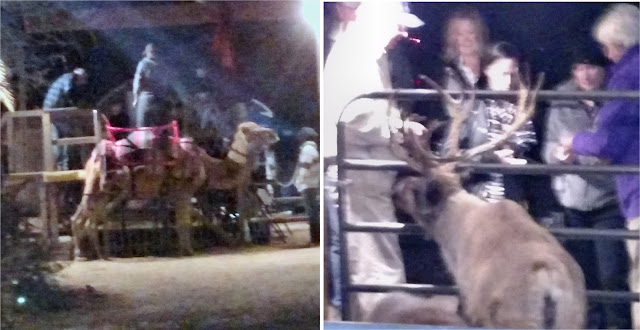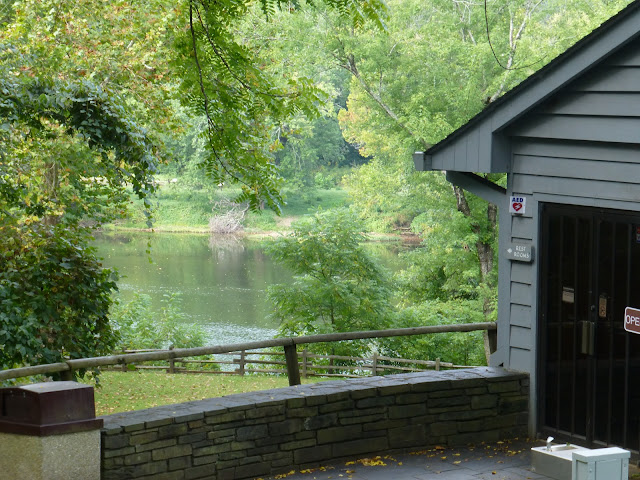The dinner was great fun and, in addition, we skated under the stars at Curry Village, visited the Badger Pass Ski Area on the road to Glacier Point, and sang Happy Birthday to Jesus at the Yosemite Chapel with birthday cake afterwards.
Most of our adventures, though, have involved the sights and sounds of San Francisco's hotels and department stores and skiing on Christmas day at Bear Valley with friends.
This year we decided it was time for another warm-weather trip and we headed for Las Vegas, Palm Desert, Newport Beach, and Disneyland.
LAS VEGAS
We spent most of our Las Vegas time at the Venetian which had great entertainment and dining in their re-creation of St. Mark's Square, but we were disappointed to see the half-hearted attempts at Christmas decorations there and in most of the other casinos we visited.
Fortunately, we knew we could count on the Bellagio Conservatory.
The Bellagio's Holiday Glamour presentation included a 42 foot White Fir from Mt. Shasta and an 18 foot Ice Princess, as well as a garden railroad, 14 foot toy soldiers, and white carnation polar bears on ice at the North Pole train station.
______
While in Las Vegas we made a trip to Lake Mead (which qualifies this trip for a National Park visit) and found it to be still depressingly low despite last year's great snow season.
But the reward for this visit was when we discovered that wild horses on your lawn are easily matched by bighorn sheep in your backyard.
One neighborhood in Boulder City is home to at least the two groups of bighorn sheep that we saw and I can now honestly say that I have seen far more bighorn sheep in Nevada than anywhere else in the country.
PALM DESERT
We next headed for Palm Desert and the Wildlights presentation at the Living Desert. This is an evening program of of over 1 million Christmas lights that allowed us to see the nocturnal animals in action. Unfortunately, the other animals simply seemed to be annoyed with the crowds that were keeping them from their sleep.
The giraffes didn't know what to make of us and stayed behind a hill with only their necks and heads above the horizon watching us carefully.
The wild dogs raced around their compound watching all of the small children very carefully. I think a number of the parents were oblivious to the implication.
Surprisingly, most of the smaller members of the cat family were curled up sleeping and tried to ignore us.
The G-Scale railroad was decorated for Christmas and a half-dozen trains ran their routes over the 3300 feet of rail so there was always something marvelous to see.
For the kids there were camel rides and reindeer feedings. The reindeer being fed were on the small size, no bigger than a pony, and well-qualified to be some of Santa's "eight tiny reindeer."
Even with all of the National Parks we've visited, I've never before seen such a wide variety of different states' plates in one place. I know the Coachella Valley is a popular winter destination but this just seemed exceedingly odd.
Later, we ate lunch at an outdoor cafe and watched the kids on the skating rink in near 80-degree temperatures and then we knew we were in California, for sure.
NEWPORT BEACH
"From the Desert to the Sea ..." was how Jerry Dunphy opened his TV news segment when we lived in Southern California and that's what we did on this trip, driving from Palm Desert to West Newport Beach. The tide was going out when we got there and the few remaining surfers were packing their boards on the ingenious racks that balanced the boards on their bicycles before riding away.
We then drove over to the Fashion Island Mall.
We last visited there in the early '70s when J.C. Penney was one of the anchor stores and a Michael's-type craft store was the reason we went. Today, the mall is one of the more upscale shopping centers in the country with anchors including Bloomingdale's, Neiman Marcus, and Nordstrom as well as upscale car dealerships like Tesla and Bentley.
Quite a change, but we were back for the Christmas decorations and we weren't disappointed. All of the mall was well-decorated and I was especially impressed with the Neiman-Marcus displays.
The highlight for us at the mall was the simple lunch we had at Bloomingdale's "59th and Lex." The holiday setting at a department store cafe was so reminiscent of the good times we had Christmas shopping in downtown Pittsburgh with lunch at Kaufmann's or Gimbel's cafes (or Horne's, according to Nancy, but I refuse to remember a "Tea Room").
The main Christmas tree at the mall was a bit perplexing. The signage indicated that, like the Bellagio's, this was a white fir from Mt. Shasta and it certainly was fully 90 feet tall as described. But, when I looked up close, the branches I could reach certainly seemed to be artificial. Then I peered under the tree and could see that it was indeed real. I didn't know what to make of this so to the internet I went.
And there I found the answer. As you can see from the picture, this was not exactly a perfect specimen of a tree and in true Southern California fashion, a little plastic surgery was just the thing to take care of a few minor imperfections.
DISNEYLAND
We've been to "Mickey's Very Merry Christmas Party" in Florida which was great fun and I was afraid that this Disneyland visit would be somewhat of a letdown. But I was wrong. It could hardly have gone any better or been more fun.
 |
| © Disney |
We watched the Christmas Parade with all of the Disney characters, dancing reindeer and Santa Claus himself. (This is the Disneyland parade that was recorded during its first week and broadcast by ABC on Christmas day.) Then, in the evening, we watched as Sleeping Beauty's Castle was "Frozen" as snow fell on Main Street. Great fun.
 |
| © Disney |
____________________
California Adventure has always been the poor step-child in Anaheim but change is in the air.
Soarin' used to be the main, and perhaps only true, attraction and I'm not even sure Soarin' Over the World is any improvement over Soarin' Over California.
The other California Adventure attractions have always been quite forgettable, but then we discovered the town of Radiator Springs in Cars Land.
The Pixar film, Cars, has been brought to life there with dining at the Cozy Cone Motel and Flo's V-8 Cafe and interesting attractions starring Luigi and Mater as just some of the highlights of this new land and the town was fully decorated for Christmas.
 |
| A Decorated Tire Pile |
But, of course, it would be merely entertaining except for the Radiator Springs Racers.
This full-size slot car ride is now my favorite Disney attraction and the only one that required a serious wait in line. (We were too late to get FastPasses and I have read since that the wait in line for FastPasses is longer than for most attractions and that they run out quickly since people line up even before the Park officially opens!)
The ride itself is a third-generation version of Test Track at Epcot and has been totally transformed for Cars Land.
The ride starts with a day-time tour through Ornament Valley (which is right out of the movie, including Columbia River's Multnomah Falls transported to the desert!). Then you arrive in Radiator Springs at night where you have a lively encounter with most of the characters from the movie.
But all of this is merely prelude. At this point your vehicle is prepared for the big two-car race through the desert.
The cars bolt from the start and follow a course that includes road dips and tight curves to the finish line at the entrance to Taillight Caverns. Then you ride through the cave and on to the Cavern Visitors' Center and the end of the ride.
It's a full and exhilarating experience and it's hard to believe that the actual ride time is less than 5 minutes. This was easily the highlight of our visit.
DRIVING HOME FROM SOUTHERN CALIFORNIA
The drive from Anaheim to Reno (except Victorville to Ridgecrest) was a pleasant drive under a bright winter sun with blue western skies (once we were out of the basin).
We had planned this trip carefully to avoid the worst of the traffic. We drove into Orange County on a Sunday afternoon and although we departed on a weekday morning, we expected to be going against commuter traffic most of the way. And then we discovered that the carpool lanes were hardly used and this made the freeway drive from Anaheim to Victorville a simple matter.
At Victorville, we exited to US 395 North and took it all the way home. We had never before driven on this section of our favorite road and we may not again. From Victorville to Ridgecrest the road is an undulating two-lane blacktop full of trucks. The landscape is barren and there are few places to stop on the way.
Thankfully, at Ridgecrest, US 395 merges with CA 14 and becomes a multi-lane road for a lot of the way north. We passed the turn-offs for Death Valley and Mt Whitney, stopping for lunch at Erich Shat's Bakkery in Bishop before the ascent to Mammoth Lakes.
If we had lived in Southern California this might have been our Christmas ski trip drive; instead, we continued north to the Nevada border and then safely home.
For a few more photos, go to:

















































